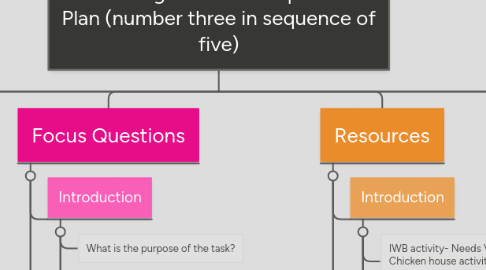
1. Theme
1.1. Chickens
1.1.1. Rich task of designing and creating a chicken coop model in pairs.
1.2. School Wide Sustainability Project
1.2.1. Recently installed veggie patch
1.2.2. Aim is to develop this program further by getting a chicken coop and chickens for the school's developing farm.
2. Focus Questions
2.1. Introduction
2.1.1. What is the purpose of the task?
2.1.2. Which materials would best suit the needs of the chickens?
2.1.3. Why would you choose a certain material over another?
2.2. Body
2.2.1. What tools will you need in order to build the chicken coop?
2.2.2. Why did you choose these specific materials?
2.2.3. How would you build the chicken coop?
2.2.4. Why would you choose to by the items at _____ compared to ______?
2.2.5. Which materials would best suit the needs of the chickens?
2.3. Conclusion
2.3.1. What have you achieved in this lesson?
2.3.2. What is one thing you can improve in your poster? How can you improve this?
2.3.3. What are you still working on?
2.3.4. What do you need help with?
3. Cross-Curricular Links
3.1. Mathematics
3.1.1. Content Descriptor: Solve problems involving purchases and the calculation of change to the nearest five cents with and without digital technologies (ACMNA080).
3.1.2. Students can investigate the prices of the materials they test in science and technology lessons and compare these between companies such as Bunnings and Masters.
3.1.3. They will calculate the differences of the prices of particular items from these stores and investigate which store would be cheaper to buy from overall.
3.2. Chemical Sciences
3.2.1. Students can explore the states of matter by testing materials (which they can use in their chicken coop model) for flexibility, strength etc.
3.3. English
3.3.1. Content descriptor: 'Plan, draft and publish imaginative, informative and persuasive texts containing key information and supporting details for a widening range of audiences, demonstrating increasing control over text structures and language features (ACELY1694)'
3.3.2. Students can create a persuasive advertisement in order to present their chicken coop design to the principal and admin
4. Austrlian Curriculum
4.1. Year Level
4.1.1. 4
4.2. Design & Technologies
4.2.1. Design and Technologies Knowledge and Understanding
4.2.1.1. Recognise the role of people in design and technologies occupations and explore factors, including sustainability that impact on the design of products, services and environments to meet community needs (ACTDEK010).
4.2.2. Design and Technologies Processes and Production Skills
4.2.2.1. Plan a sequence of production steps when making designed solutions individually and collaboratively (ACTDEP018).
4.2.2.2. Select and use materials, components, tools and equipment using safe work practices to make designed solutions (ACTDEP016).
4.2.2.3. •Generate, develop, and communicate design ideas and decisions using appropriate technical terms and graphical representation techniques (ACTDEP015).
4.3. Prior Knowledge
4.3.1. Technologies
4.3.1.1. Students have identified the qualities of a chicken coop that is most favourable to the survival of chickens
4.3.1.2. Investigated and tested the properties of materials which they can potentially use to build their chicken coops. .
4.3.2. Maths
4.3.2.1. Students should be investigating the prices of the materials they have been testing in science and technology lessons.
4.3.2.2. Students compare the prices between companies such as Bunnings and Masters in order to make an informed decision regarding the materials they will use to build the chicken coops.
5. Resources
5.1. Introduction
5.1.1. IWB activity- Needs VS Wants Chicken house activity template
5.1.2. Glogster accounts for all students
5.1.3. Visual description of task (written with pictures)
5.1.4. Printout of students' Simple Diagrams list of chicken needs
5.2. Body
5.2.1. Laptops
5.2.2. Glogster login information for students
5.3. Conclusion
5.3.1. Self Reflection Traffic Light sheets for each student
6. Lesson Steps
6.1. Introduction
6.1.1. Collaboratively revise the qualities of an effective chicken coop by typing specific features onto the Needs/Wants chicken house template. (This should be discussed in depth in lessons preceding this one)
6.1.2. Revise the rules for scientific drawings
6.1.3. Explicitly Explain the task to students and model the use of SimpleDiagrams on the IWB:
6.1.3.1. 1. Students have to use the SimpleDiagrams printout of chicken needs, Properties of Matter science investigation results and maths financial budget to decide which materials they will use to make their chicken coop model.
6.1.3.2. 2. Students will make use of the Glogster program to create a poster which includes:
6.1.3.2.1. 2a. Statement of purpose
6.1.3.2.2. 2b. List of equipment/tools
6.1.3.2.3. 2c. List of materials
6.1.3.2.4. 2d. Brief budget (how much each item costs and a suggested store to buy from)
6.1.3.2.5. 2e. Steps of process
6.2. Body
6.2.1. Students complete their Glogster posters with guidance of teacher where required.
6.2.2. Ensure to allow students to share their work with a peer at regular intervals throughout the lesson.
6.3. Conclusion
6.3.1. Students share their ideas and progress of their posters with their partners.
6.3.2. Each partner identifies:
6.3.2.1. 1. One thing their partner did well.
6.3.2.2. 2. One thing their partner can think to improve on.
6.3.3. Students use the self reflection tool to write or draw the following information:
6.3.3.1. Green: Something they are confident with
6.3.3.2. Orange: Something they are working through
6.3.3.3. Red: Something they need help with
